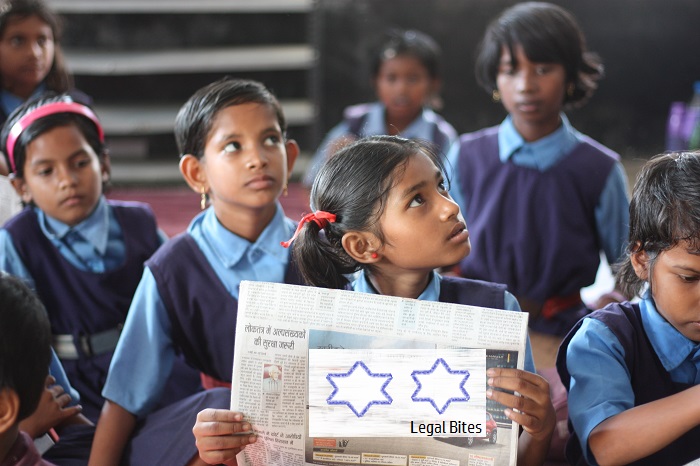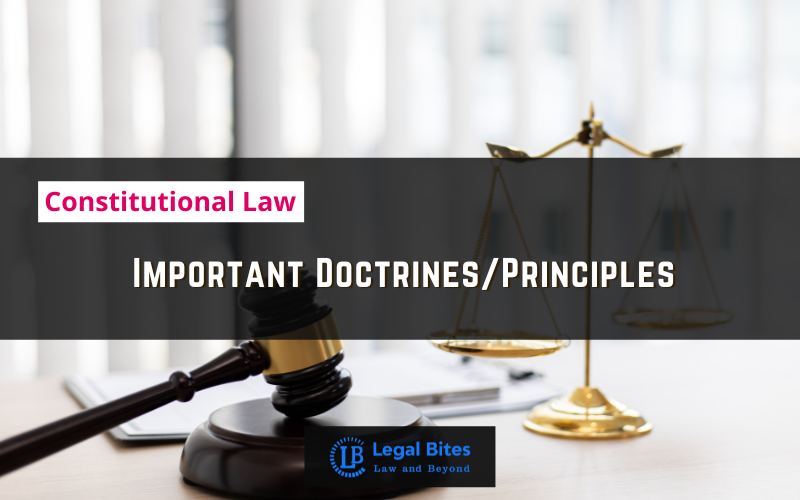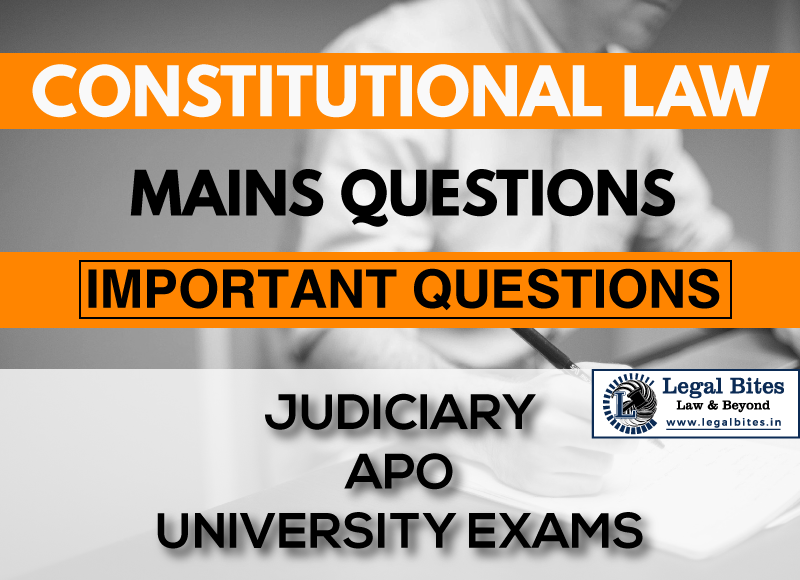The Right to Education
The Right to Education | Overview Introduction Right To Education In India: Implications And Challenges Constitutional Perspective of the Right to Education The Provisions of The Ninety-Third Amendment Bill, Its Reaction, And Its Into The Eighty-Sixth Amendment Act Conclusion This article examines the significance of the Right to Education keeping in mind the provisions of Article 21A in… Read More »
;
The Right to Education | Overview Introduction Right To Education In India: Implications And Challenges Constitutional Perspective of the Right to Education The Provisions of The Ninety-Third Amendment Bill, Its Reaction, And Its Into The Eighty-Sixth Amendment Act Conclusion This article examines the significance of the Right to Education keeping in mind the provisions of Article 21A in mind. It focuses on the judicial interpretation that has seen a plethora of changes. Cases like...
The Right to Education | Overview
- Introduction
- Right To Education In India: Implications And Challenges
- Constitutional Perspective of the Right to Education
- The Provisions of The Ninety-Third Amendment Bill, Its Reaction, And Its Into The Eighty-Sixth Amendment Act
- Conclusion
This article examines the significance of the Right to Education keeping in mind the provisions of Article 21A in mind. It focuses on the judicial interpretation that has seen a plethora of changes. Cases like Mohini Jain v. State of Karnataka and Bandhua Mukti Morcha have been discussed surrounding the right to education. There is a growing recognition of the centrality of education in people’s lives. Education works as a tool for not only making an individual aware and responsible but also instils a sense of empowerment.
Right to Education is a fundamental right guaranteed under Article 21A of the Constitution. It states that every child between the age of 6-14 has the right to free and compulsory education. It is a journey that has quite a lot of challenges on its way.
Introduction
When one thinks of their fundamental rights, does the right to education fall on the list? It right to education considered worthy enough to be considered an essential right or maybe a human right. Education encourages freedom of an individual and empowers one to yield important development benefits. However, good educational opportunities seem like the end of a tunnel to most children and adults.
Not only now, but even in the olden days, education was considered an important tool. The importance of education was developed by “Bhartruhari” in his book “Neethishatakam” at the earlier stage of 1st century BC.
Prescriptive instruments of UNESCO and the United Nations establish certain obligations. The association of the international community for acknowledging the right to education holds great importance to these instruments. Every individual has the right to enjoy quality education without discrimination or hindrance and these instruments play a vital role in it. It is the government’s responsibility to provide remarkable education so that the ambit of success within its purview widens. Moreover, the government has to fulfil both legal and political obligations when it comes to the upliftment of the masses.[1]
For marginalized people to come out of the shackles of poverty and the vicious cycle of illiteracy so that they participate as responsible and aware citizens, education acts as a tool which empowers them to do so.
Out of the total population of children in the whole world, 19% reside in India. This equates to the fact that India is a young country and holds a lot of potentials. An enormous amount of youth, which is the case in India, can be considered quite resourceful. If a comparison is made to countries like China, where the majority of the population has already aged, India stands at an advantage of having a young population. However, something to ponder over is that the quality and the productiveness outweighs quantity. Considering India to be a country with a young population, the concern is to be drawn to the point that the maximum number of them are not educationally sound and find themselves trapped in the shackles of poverty.
One-third of the illiterate population of the world resides in India. Literacy rates have increased in the past years, but the growth is not that substantial. Surprisingly, the rate has been slowing drastically over the years. The literacy rate has declined from 12.8% in 2001 to a staggering 9.2% in 2001.[2]
Right To Education In India: Implications And Challenges
Free and compulsory education has not been an easy task. Considering the numerous legislative enactments in the past which have failed the downtrodden groups and favoured the privileged urban elite, it is a major shift for the government to implement and guarantee quality education. 60% of the 110 million children who drop out of the schooling system, drop out by the 8th grade.[3]
It has been consistently seen that the children who dropout continue to reflect inequality and fail to rise above from the shackles of poverty and the social fabric. The main priority groups which in the literal sense are benifitted – the upper caste children, or the children from well off urban households – are the people who have secured a social position and who influence their power on the society. And right in the middle of the axes, lies the gender gap, which stays more or less consistent across social groups.[4]
The main reason behind India’s ill performance in securing a sound and an equitable education for all has been the bridge between operational framework and discourse in the educational policy efforts. It cannot be denied that the Indian Constitution has had a wide range of commitments regarding education and equality, what cannot be ignored are the historical disadvantages faced by certain social groups, and the rampant discrimination which withers away the ambitious vision developed at the inception of the modern Indian state.
Constitutional Perspective of the Right to Education
The main aim of the Indian Constitution is to deliver social justice. According to expert opinion, education forms the cornerstone for making a provision of equality of opportunity a reality. Education as the essence of social transformation has therefore been recognized by the Indian Constitution.
A division bench of the Supreme Court comprising of Justice R.M. Sahai and Justice Kuldip Singh, in the case of Mohini Jain v. State of Karnataka[5], laid down the inception of right to education as a fundamental right. It was held that:
“the right to education flows directly from the right to life. The right to life and dignity of an individual cannot be assured unless it is accompanied by the right to education.”
Further, in the landmark judgement of J.P. Unnikrishnan v. State of Andhra Pradesh[6], the reasonableness of Mohini Jain judgement was dissected by a constitution bench where the extent to which the right to education can be enforced as stated in the following words:
“The right to education further means that a citizen has a right to call upon the State to provide educational facilities to him within the limits of its economic capacity and development.”
The Apex Court held in the case of Bandhua Mukti Morcha v. Union of India, that the genesis of right to education can be traced to Article 21 of the Indian Constitution which guarantees right to life and personal liberty.[7] During the articulation of such an interpretation, the court did not only focus on the provisions of Articles 45, 41 and 46 of the part VI of the constitution but only considered the International Covenant on Economic, Social and Cultural Rights.[8] In defining the right to education, the Court included the provisions that enable to provide every child between the age of 6 and 14, free and compulsory education, thereafter subject to constraints of development of the state.[9]
The Provisions of The Ninety-Third Amendment Bill, Its Reaction, And Its Into The Eighty-Sixth Amendment Act
Due to the addition of the 93rd Amendment Bill, there were three changes that were brought to the text of the Constitution: a) Article 21A being added as a new article; b) Article 45 was amended; c) clause (k) being inserted to Article 51A, which deals with the Fundamental Duties. The bill suggested the following language for a new article 21A:
“The State shall provide free and compulsory education to all children of the age of six to fourteen years in such manner as the State may, by law, determine.”[10]
The following provisions stirred an outburst of criticism ranging from NGOs to even social activists. Even though the right to education was being welcomed by enthusiasm as it being a fundamental right, it was also criticized in certain ways. Broadly, there were three criticisms:[11]
- The first criticism concerns itself with the education of only those children who lie between a certain bracket, i.e. 6-14 years of age. This was a clear violation of every child below the age of fourteen having the fundamental right to primary education which was held in the Unni Krishnan decision. Further, the age between three and six is considered substantially crucial in terms of the developmental process during this stage.
- The amendment of Article 51A rendered responsibility on the parents to educate the children between the age group of 6-14. This circulated hostility as it was considered the government’s easy way to waive the responsibility of children and burden the parents with the same, who are often too poor to even able to carry that burden.
- The bill could also not define the terms “free” and “compulsory” which created a cloud of ambiguity around the issue of quality of education that would be imparted to the concerned children.
In recent times, the debate has taken its own version as many leaders of the opposition and social activists believe this bill to be the brainchild of the current NDA government, which is pressurised from its right-winged Hindu supporters, with an attempt to communalize the content of the education provided to the young children.
Conclusion
In India, the principle of availability of higher education on the basis of merit is generally neglected, with the result that the standard of scholarship is not what it should be for our universities. To make it more comprehensive, there needs to be an adaptation of a holistic approach where the more technical and vocational school should open, and after discovering the capacity of each child, to diver to such schools with a practical rather than an academic bent of mind.
Each generation looks up to the next generation hoping them to build a better nation than the present. Hence, the utmost concern should be delivering quality and affordable education to all so that the youth of the nation can be empowered rather than being hopeless. Even though we have laws that implement free and compulsory education, it is still a very far-fetched dream due to poverty and various prejudices in society.
[1] Joseph, Jasmine, and Daniel Mathew. “Right to Education – From Dreams to Reality: A critical review of the West Bengal Right to Education Rules, 2012.” Journal of the Indian Law Institute, vol. 54, no. 4, 2012, pp. 539–556. JSTOR, www.jstor.org/stable/43953613. Accessed 22 Apr. 2020.
[2] Joseph, Jasmine, and Daniel Mathew. “Right to Education – From Dreams to Reality: A critical review of the West Bengal Right to Education Rules, 2012.” Journal of the Indian Law Institute, vol. 54, no. 4, 2012, pp. 539–556. JSTOR, www.jstor.org/stable/43953613. Accessed 22 Apr. 2020.
[3] Wadhwa 2001
[4] Ayushmaan, Aishwarya, and Deepthi Bavirisetty. “Right to Education: Edging closer to realisation or furthering judicial conundrum?” National Law School of India Review, vol. 26, no. 1, 2014, pp. 87–101. JSTOR, www.jstor.org/stable/44283784. Accessed 21 Apr. 2020
[5] (1992) 3 SCC 666, 677.
[6] (1993) 1 SCC 645, 765 para 226.
[7] INDIA CONST. part. III, art. 21.
[8] International Covenant on Economic, Social and Cultural Rights, G.A. Res. 2200A (XXI), U.N.
GCIAOR, 21st Sess., Supp. No. 16, at 49, U.N. Doc A/6316 (1966), 993 U.N.T.S. 3, entered into force
Jan. 3, 1976.
[9] Vijayashri Sripati & Arun K. Thiruvengadam, India – Constitutional Amendment Making
[10] Constitution (Ninety-third Amendment) Bill, 2001.
[11] Akbar, Syed Ali. “The Right to Education.” The Indian Journal of Political Science, vol. 13, no. 3/4, 1952, pp. 89–94. JSTOR, www.jstor.org/stable/42743404. Accessed 21 Apr. 2020.




